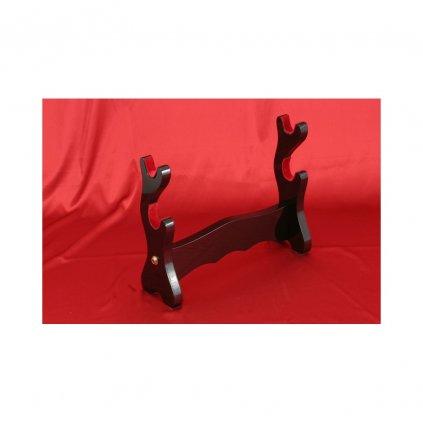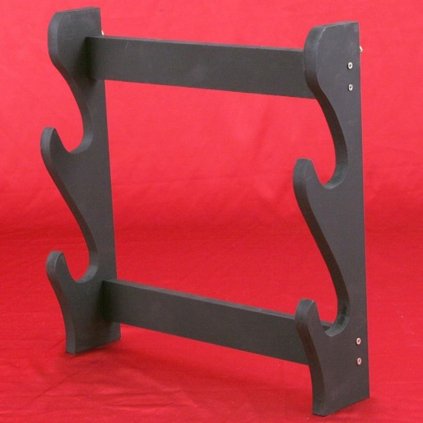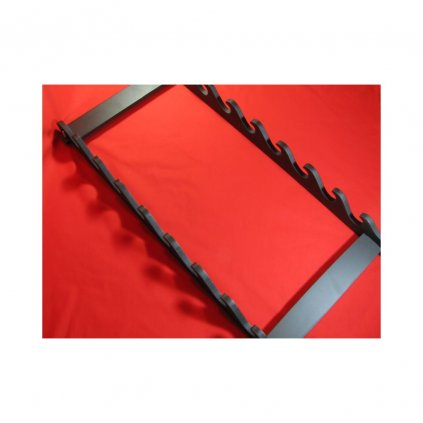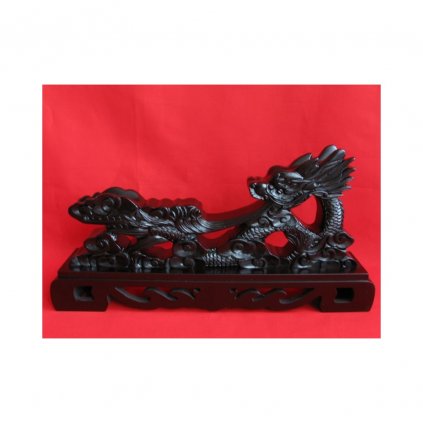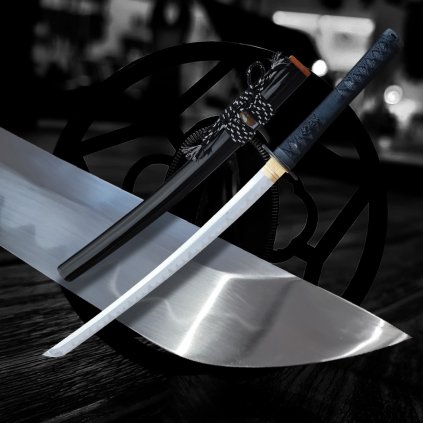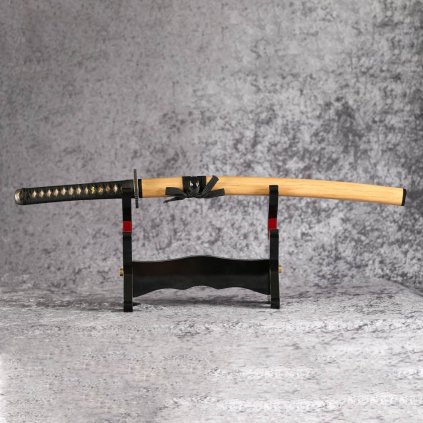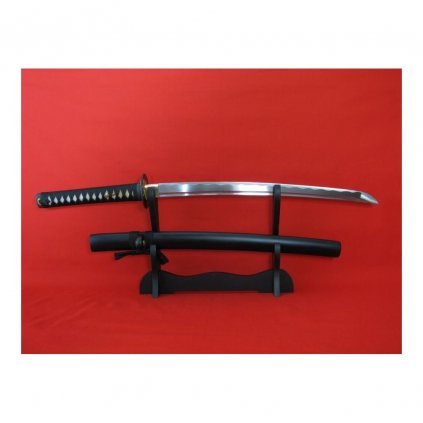katana Yamagumo made of AISI 1045 carbon steel - polished hamon imitation
Code: K-747



Related products
Product detailed description
Katana Jamagumo carbon steel blade AISI 1045
very well made replica of Japanese sword
Fully functional replica of Japanese sword Yamagumo with polished imitation of hardening (hamon) and Bo-Hi groove on the blade. Sharp (polished) samurai sword KATANA will find its use as a decoration, but also for active martial arts training. Katana is not suitable for cutting harder materials. The steel is not partially hardened (hamon is only polished) and therefore has a low degree of hardness. Chopping hard materials would leave marks on the blade of the sword. The really successful combination of colour while retaining the classic motifs makes this katana an attractive sword at an affordable price. The black Ito and Sageo match the glossy black lacquer on the saya. The katana can be disassembled and comes in a black canvas bag and a paper box. The company Dellinger disclaims any liability for injury or damage resulting from use. Keep the katana out of the reach of children ! Any handling of the samurai sword is your own responsibility. Remember, you are holding a deadly weapon in your hands!Thekatana 刀 is a type of samurai sword that dates back to around the 15th century AD. The katana has a curved blade, just like a sabre. The hilt (tsuka) is oval in cross-section, topped with a steel fighting guard (tsuba). The length of the katana blade starts from about 60 cm. The samurai wore the katana tucked behind his kaku-obi belt, blade up, along with a short sword Wakizashiso that he could respond to a sudden enemy attack directly from the scabbard. The pair of katana and wakizashi swords was called the daiō and was the symbol of the samurai class. The two-sword daiō set became standard equipment for samurai. The long katana was used for fighting in open spaces, while the short wakizashi or tantō was used for fighting in confined spaces or for ritual suicide called seppuce.
Forged steel blade AISI 1045 of the highest quality. The blade is in Maru configuration, i.e. forged from one compact bar of steel. AISI 1045carbon steel is a very popular steel used in the manufacture of katana, sword and knife blades. The production of this blade goes through several polishing and sharpening processes.
Gutter Bo-Hi brings lightness to the katana and is responsible for the impressive sound even with a light swing of the katana or wakizashi. This sound is called "Tachi-Kaze" (the sound of the wind of the sword) in Japanese. How loud you hear the sound will depend on the speed and proper technique of the cut. Swords with the Bo-Hi groove are often used by martial arts students because they know immediately which of their slashes were good and which need to be improved. This groove is often called the "blood groove", although its purpose has nothing to do with blood. Combined with proper groove tapering, the blade can be 20 to 30% lighter than a blade without a groove without significant loss of strength and stability. The groove usually tapers together with the tapering blade. The production of Bo-Hi groove blades is a bit easier than the classic full blade. A sword without a groove has higher strength and resistance to damage. The finest swords are usually without this groove.
Tip shapes (kissaki)
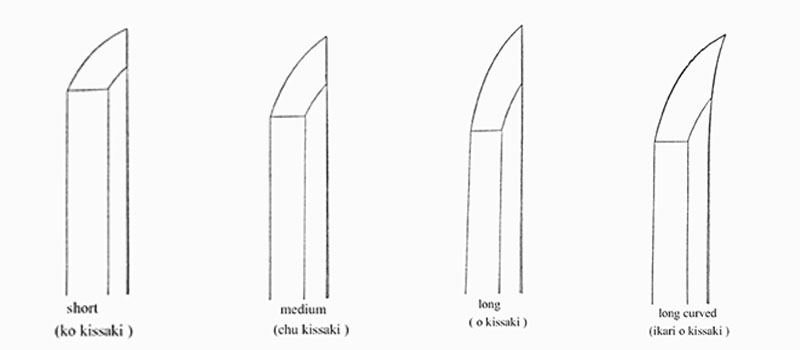
The katana can be disassembled and any part can be replaced according to your wishes - we recommend to buy a set of tools and accessories

Technical description:
| Total length of the katana: |
103 cm |
| Blade length: |
71 cm |
| Handle length: | 27 cm |
| Blade material: |
AISI 1045 Carbon Steel |
| Strength / height of the blade at habaki: | 0.7 / 3.2 cm |
| Blade hardness: | 55-58 HRC |
| Hamon: | polished imitation |
| The blade: | full tang, sharp, secured with 2 pins (mekugi) |
| Saya: | hardwood with Sageo wrap |
| Saya length: | 76 cm |
| Tsuba (patronage): | zinc alloy |
| Tsuka (handle): | wooden core, synthetic ITO wrap |
How to take care of a katana and what not to do with it....
in general, all activities except for traditional chopping test techniques, which involve chopping into special mats
![]() Cutting branches, trees and bushes: for this activity people have developed other tools such as axes or machetes.
Cutting branches, trees and bushes: for this activity people have developed other tools such as axes or machetes.
![]() Chopping, or swordplay with another sword: destructive damage to the blade of a samurai sword - samurai avoided any direct contact with the enemy to avoid damaging the blade. The repair was long and expensive.
Chopping, or swordplay with another sword: destructive damage to the blade of a samurai sword - samurai avoided any direct contact with the enemy to avoid damaging the blade. The repair was long and expensive.
![]() Nnever wear a sharp samurai sword with the blade exposed in public: Always keep your sword in the Saye (scabbard). In Germany and other EU countries, this is even an obligation prescribed by gun law.
Nnever wear a sharp samurai sword with the blade exposed in public: Always keep your sword in the Saye (scabbard). In Germany and other EU countries, this is even an obligation prescribed by gun law.
![]() Never insert a dirty blade into the sayi: If you are performing chopping tests on fruit, clean and preserve the blade immediately after chopping, otherwise the blade will rust and oxidize.
Never insert a dirty blade into the sayi: If you are performing chopping tests on fruit, clean and preserve the blade immediately after chopping, otherwise the blade will rust and oxidize.
![]() Never leave your sword in a damp place such as a porch, shed, cellar or conservatory: This is certainly not the treatment this traditional weapon deserves. Always clean the blade after use, brush with oil and store the sword in a dry place.
Never leave your sword in a damp place such as a porch, shed, cellar or conservatory: This is certainly not the treatment this traditional weapon deserves. Always clean the blade after use, brush with oil and store the sword in a dry place.
Dellinger guarantee: Products supplied by Dellinger come with a 100% satisfaction guarantee or a risk-free money back guarantee. We guarantee an excellent product that will give you the best service and is proven by many satisfied customers. Each piece is wrapped in luxury packaging and can be a wise gift solution for a birthday, wedding or Christmas. Every product that Dellinger offers is carefully inspected. We bring you a lifetime warranty against any hidden defects. If you have any questions - our team is fully at your disposal and will try to help you in any (even unpleasant) situation.
Additional parameters
| Category: | katana |
|---|---|
| Warranty: | 2 years |
| Weight: | 1.22 kg |
| steel - blade material: | karbonová ocel 1045 |
| the length of the blade (nagasa) from the end of the habaki: | 2,30 Shaku - 69,50 cm |
| Hamon: | no |
| Bo-Hi groove: | yes |
| suitable for sectional tests: | No |

